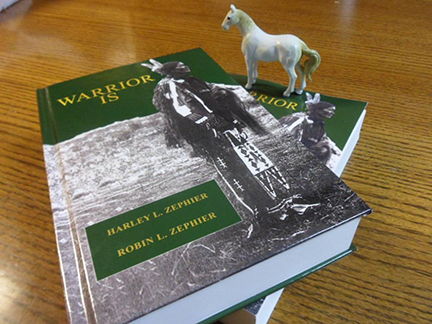“Warrior Is” Answers Questions about the Battle at the Little Big Horn

As the only living descendants of Mato Niyanpi, Robin L. Zephier (University of South Dakota, 1983) and his older brother Harley L. Zephier, self-published “Warrior Is” in 2017. They tell Mato Niyanpi’s life story as the Mnincoju Lakota warrior who killed Lt. Col. George Custer at the Greasy Grass Battle at the Little Bighorn in Montana on June 25, 1876.
“It involves the telling of a long-hidden truth about one of the most well-known historical events in the history of mankind and Grandmother Earth, the Battle of the Greasy Grass also known as the Battle of the Little Bighorn,” Zephier said. “The date was June 25, 1876, and the events of that day have been the subject of many books, articles, studies, documentaries, movies and discussions over the past 146 years.” In the book, the brothers review details of their great grandfather as the warrior who killed Custer.
“We look forward to the notion that visitors at the Little Bighorn Battlefield National Park (in Montana) will have access to a personal biography of one of the warriors who played such a prominent role in the battle itself on June 25, 1876,” Zephier said.
In late September 2010, Zephier’s family visited the park via a permit process and performed a greatly significant spiritual ceremony on top of Last Stand Hill. Zephier said many years of planning went into the September 29, 2010, ceremony in order to obtain the necessary spiritual permission to tell Mato Niyanpi’s (Saved By Bear’s) life story and the secrets about his direct role in the battle and the outcome thereof.
“Our great grandfather is in fact, the proud Lakota warrior who took the life of Lt. Col. George Armstrong Custer on June 25, 1876, on Last Stand Hill during the battle that day. The sacred ceremony provided us with the necessary spiritual permission to speak publicly about these things which had been kept as a close family secret for 141 years, and granted us the permission to begin writing our book ‘Warrior Is.’ It is ironic and satisfying, that despite the fact it took so long to write and to publish, the book came out nearly seven years to the day of that September 29, 2010, sacred ceremony on Last Stand Hill,” Zephier said. Their great grandfather became known as Scar Leg later in his life after he was a survivor of the Wounded Knee Massacre in 1890.
In addition to the book, Robin’s brother Harley created the Greasy Grass Battle Map from chapter 16: Our Battle, which is available as a poster-sized document folded in map-style. The map shows the progress of the warriors as they move along the spiritual path on their way up the hillside toward the confrontation with Custer and his men on Last Stand Hill.
On June 25, 2018, the 142nd anniversary of the battle, the brothers held a presentation near Last Stand Hill at the Greasy Grass Battlefield (aka Little Bighorn Battlefield). “We shared many details of the story, including a discussion about the Thirteen Warriors movements as they advance upon Last Stand Hill and Custer and his men,” Zephier said. “We explain the background as to why the battle was fought, and why the battle and the outcome has so much significance, then, but mostly now, in our present world, for all people and for Unci Maka, Grandmother Earth. Our message in bringing this story forward to the public is in the name and the spirit of peace, unity, tolerance and love. We hope to be able to light a spark which will lead to a flame of openness and acceptance that one day, this battlefield that has been viewed for seven generations as a field of conflict, war, suffering and death, will in fact at some point in the near future, be forevermore going forward from that date, viewed as a Healing Ground, a spiritual healing place for peoples of all races, all faiths, all beliefs, all backgrounds and beginnings, to look to and to feel for themselves, a positive energy to take home with them to their friends and families, to share in the growth of a better world and a better means of community for all children of Grandmother Earth.”
By holding events such as the program at the Greasy Grass in 2018, the brothers feel they can share a long-dormant truth to answer the questions of “why,” “how” and “who else” was also on that hill known as Last Stand Hill. They hope to help others to see life and love through their hearts and spirits, and not just through their eyes alone.
The Zephier family also plans to create a Culture Camp in the He Sapa (sacred Black Hills) to bring the world cultures together sharing the parallels of human spiritual existence for the common good of humanity. “Encouraging people of all origins, races and backgrounds to participate, and to support the messages and the undying principles of peace, unity, tolerance and love, at a time when these things are so desperately needed in the present, within the Sacred Hoop, the Circle of Life.” Zephier said.
Robin lives in the sacred He Sapa/Black Hills of western South Dakota with his wife Patti and their little JoJo, and is a practicing attorney and an advocate for the indigenous peoples and causes and for Unci Maka/Grandmother Earth. Harley lives in Thunder Butte, South Dakota and is the spiritual teacher and sundancer who has carried the sacred story forward. Harley will be inducted into the South Dakota High School Basketball Hall of Fame, class of 2022, in August.
